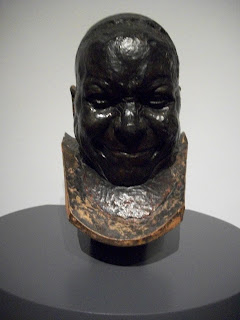





The wonder of Belvedere, Prince Eugene of Savoy’s summer palace, besides the lower building being the guesthouse for a summer house, is in its Gesamtkunstwerk: the work of art in its entirety. This entire park is a work of art. From the gardens pruned to perfection, lined with beautiful white sculptures to the fountains ordained with even more statues. Even before one enters the palace it is already breathtaking. The entrance is grand and I felt rather underdressed in my jeans and tank top as I imagine the nobles welcomed as Prince Eugene’s guest, up the staircase and into the welcoming hall adorned with crystal chandeliers and frescoed ceilings. We can see that the Turks hold up their defeater, Prince Eugene’s ceilings for eternity.
From the welcoming hall we made our way to the collection of Messerschmidt heads. The details of expressions on these faces are unbelievable. They are so lifelike I feel as if I am staring into faces frozen in time. It is quite fascinating to note that the insane artist sculpted these faces to ward off demons. I wonder how effective these busts were.
In this wonderfully Baroque Palace there is a god-awful room painted in a modern-esque purple with shapes. Dr. O is not a fan of this decision, among others, the present director has made. I agree. The color is ridiculous and has a cheap and tacky feel to it. This is a room in the Belvedere, not a place to experiment with horrendous colors on an accent wall. I was disappointed when I left without finding a comment box. I would show the world a picture of this disgrace, but another one of the changes the director implemented was to ban photographing inside the Belvedere. I do not apologize for the pictures I stole of the faces.
In addition to Messerschmidt’s faces and an ugly wall, there were a number of paintings by Gustav Klimt. My favorite piece of Klimt’s was his unfinished piece. I liked the mystery, seeing a painting and wondering what it could have been, and the revelation, evidence of the way an artist worked. It was quite fascinating. I learned that I am not a fan of Klimt’s artwork but that I can appreciate him for the sake of art and his role in the Secession movement: freedom in art. I am an American; freedom is a right.
Finally, at the Belvedere I stand face to face with my first experience with Biedermeier art. Aesthetically speaking, I must confess I am a fan. I would have the Ocean’s Eleven team steal one of these before I would have them steal Baroque art or one of Klimt’s (however, I have not taken into consideration the price tag of one or the other—I can still be bought at this point). Right now I'm more or less thinking about which calendar art I would own. While I would not say that I am one of “modest ambitions and sober pleasures,” I like the idea of family and privacy.[1] With that said, the Metternich regime would drive me crazy and I would have to rebel in some way. Coerced privacy is not something I would choose to participate in.
[1] Nicholas Parsons, Vienna a Cultural History (New York: Oxford University Press, 2009), 195.







No comments:
Post a Comment